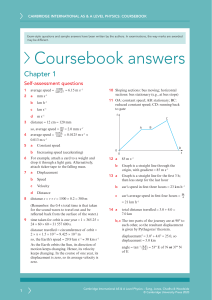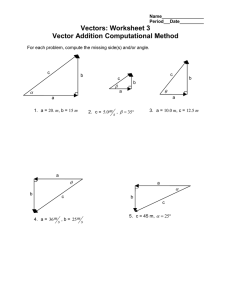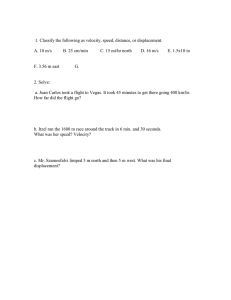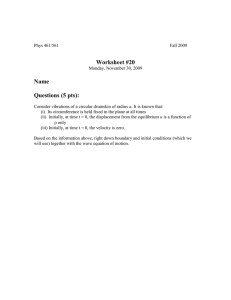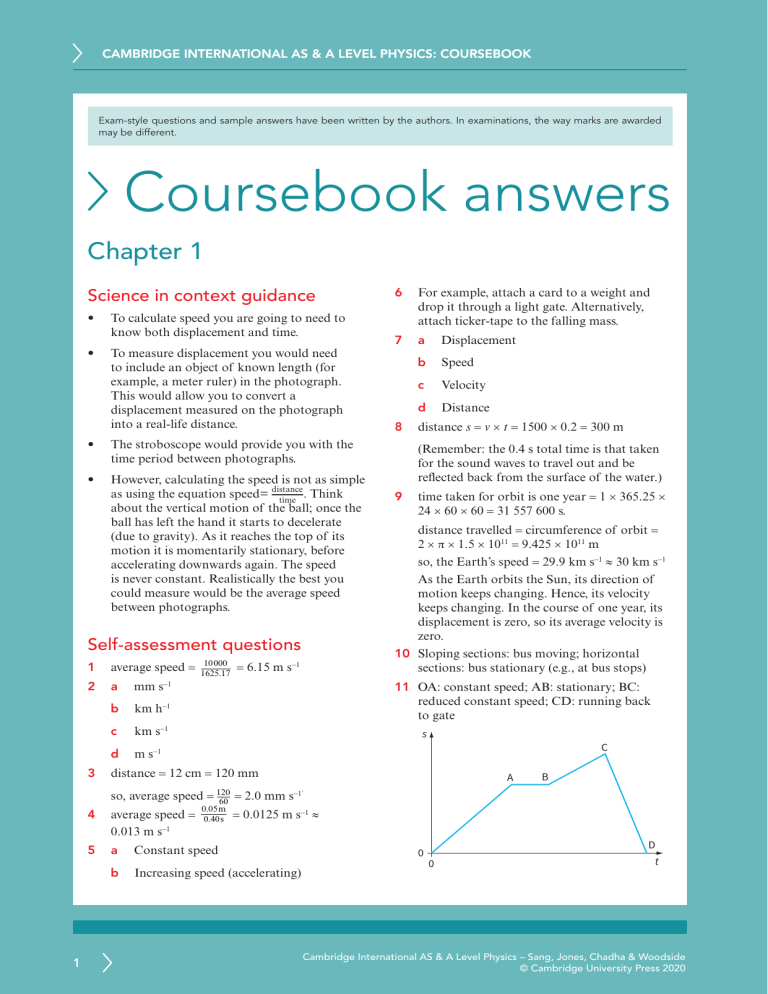
CAMBRIDGE INTERNATIONAL AS & A LEVEL PHYSICS: COURSEBOOK Exam-style questions and sample answers have been written by the authors. In examinations, the way marks are awarded may be different. Coursebook answers Chapter 1 Science in context guidance • To calculate speed you are going to need to know both displacement and time. • To measure displacement you would need to include an object of known length (for example, a meter ruler) in the photograph. This would allow you to convert a displacement measured on the photograph into a real-life distance. • The stroboscope would provide you with the time period between photographs. • However, calculating the speed is not as simple as using the equation speed= distance . Think time about the vertical motion of the ball; once the ball has left the hand it starts to decelerate (due to gravity). As it reaches the top of its motion it is momentarily stationary, before accelerating downwards again. The speed is never constant. Realistically the best you could measure would be the average speed between photographs. Self-assessment questions 1 average speed = 2 a mm s−1 b km h-1 c km s−1 d 10000 1625.17 = 6.15 m s−1 6 or example, attach a card to a weight and F drop it through a light gate. Alternatively, attach ticker-tape to the falling mass. 7 a Displacement 8 b Speed c Velocity d Distance distance s = v × t = 1500 × 0.2 = 300 m (Remember: the 0.4 s total time is that taken for the sound waves to travel out and be reflected back from the surface of the water.) 9 t ime taken for orbit is one year = 1 × 365.25 × 24 × 60 × 60 = 31 557 600 s. distance travelled = circumference of orbit = 2 × π × 1.5 × 1011 = 9.425 × 1011 m so, the Earth’s speed = 29.9 km s−1 ≈ 30 km s−1 As the Earth orbits the Sun, its direction of motion keeps changing. Hence, its velocity keeps changing. In the course of one year, its displacement is zero, so its average velocity is zero. 10 Sloping sections: bus moving; horizontal sections: bus stationary (e.g., at bus stops) 11 O A: constant speed; AB: stationary; BC: reduced constant speed; CD: running back to gate s C −1 m s 3 distance = 12 cm = 120 mm 4 so, average speed = 120 60 0.05 m average speed = 0.40 s A B = 2.0 mm s −1` = 0.0125 m s−1 ≈ 0.013 m s−1 5 1 a Constant speed b Increasing speed (accelerating) 0 D 0 t Cambridge International AS & A Level Physics – Sang, Jones, Chadha & Woodside © Cambridge University Press 2020 CAMBRIDGE INTERNATIONAL AS & A LEVEL PHYSICS: COURSEBOOK 12 a 85 m s−1 b 13 a Graph is a straight line through the origin, with gradient = 85 m s−1 b 17.3 m s−1 ≈ 17 m s−1 c 43.9° ≈ 44° to the vertical 18 a 10 m s−1 North Graph is a straight line for the first 3 h; then less steep for the last hour b 0 m s−1 b car’s speed in first three hours = 23 km h−1 c 7.1 m s−1 045° or N45°E c 84 4 d 7.1 m s−1 315° or N45°W car’s average speed in first four hours = Exam-style questions = 21 km h−1 14 atotal distance travelled = 3.0 + 4.0 = 7.0 km b, c T he two parts of the journey are at 90° to each other, so the resultant displacement is given by Pythagoras’ theorem. 1 A[1] 2 C[1] 3 a ( ) 4.0 3.0 b he car’s direction of motion keeps T changing. Hence, its velocity keeps changing. In the course of one lap, its displacement is zero, so its average velocity is zero.[1] c istance travelled in 1 minute = d 0.5 × circumference but, displacement = diameter of track[1] circumference = π 4000 m = = 1270 m[1] π = 53° E of N or 37° N 15 a, b8.5 km; 48° W of S or a bearing of 228° A 48° 45° 8.5 km 8.0 km π W π SE 12.0 km 4 b magnitude2 = 2.02 + 0.82 = 4.64 so magnitude = 4.64 = 2.154 ≈ 2.2 m s−1 ( ) vertical 18 ms–1 angle at B = tan−1 [1] ( 800 600 ) displacement = 1000 m at an angle 53° W of N or a bearing of 307°[1] direction = tan−1 02.8 ≈ 22° to the direct route (68° to the river bank) 17 a resultant 25 ms–1 a By Pythagoras’ theorem, distance2 = 6002 + 8002 m2[1] = 1000 000 = 1000 m [1] 16 S wimmer aims directly across river; river flows at right angles to where she aims. So, resultant velocity is given by geometry: 44° [1] = 4.0 km[1] displacement2 = 3.02 + 4.02 = 25.0, so displacement = 5.0 km angle = tan−1 of E distance = speed × time 120 × 2.0 = 60 c 5 velocity = 1000 60 = 16.7 m s−1[1] at an angle 53° W of N[1] a distance in car = 0.25 × 60 = 15 km[1] total distance = 2.2 + 15 = 17.2 km[1] horizontal 17 ms–1 2 Cambridge International AS & A Level Physics – Sang, Jones, Chadha & Woodside © Cambridge University Press 2020 CAMBRIDGE INTERNATIONAL AS & A LEVEL PHYSICS: COURSEBOOK b By Pythagoras’ theorem, displacement = 2.22 + 152 = 15 200 m[1] at an angle = tan−1 215.2 [1] = 8° E of N or a bearing of 008°[1] ( ) c b t ime for 2.2 km at 2.0 m s = = 1100 s[1] d average speed = distance time 17200 = [1] 2000 = 8.6 m s−1[1] e average velocity = displacement time 15200 = [1] 2000 = 7.6 m s−1[1] resultant velocity = 1.02 + 2.402 24 speed = distance = 0.1 [1] time = 240 cm s−1[1] c 2200 2 −1 total time = 1100 + 900 = 2000 s[1] 6 At least two examples: 108 − 84 = 24, 84 − 60 = 24, 60 − 36 = 24 cm[1] 108 + 2 × 24[1] = 156 cm[1] d distance = 240 × 0.001 = 0.24 cm[1] The smallest scale division on the ruler is 2 cm and so each dot is blurred by about 1/10th of a scale division. This might just be observable but difficult to see[1] 10 a Vector quantities have direction, and scalar quantities do not.[1] One example of a vector, e.g., velocity, acceleration, displacement, force[1] One example of a vector, e.g., speed, time, mass, pressure[1] 100 km h–1 = 2.6 m s [1] at an angle of tan−1 12..04 [1] −1 ( ) 7 N = 23° E of N or a bearing of 023°[1] a Distance in a (particular) direction[1] b resultant hen athlete returns to his original W position or the start[1] 500 km h–1 (direct) distance from original position zero[1] 8 boy s / m 40 38 36 35 girl 30 25 20 15 b Scale stated and diagram of sufficient size[1] Resultant velocity 510 (±10) km h−1[1] 11° W of N or a bearing of 349° (±3°)[1] 10 c 5 11 a 0 9 3 0.25 × 510 = 128 ≈ 130 km 11° W of N[1] velocity of aircr B 0 1 2 3 4 5 6 7 8 9 10 11 12 t/s 7.5 m s–1 a Straight line from t = 0, s = 0 to t = 12, s = 36[1] b Correct vectors drawn and labelled[1] traight line from t = 0, s = 0 to t = 5, S s = 10[1] 15 m s–1 A Straight line from t = 5, s = 10 to t = 12, s = 38[1] Correct vector diagram[1] Velocity of aircraft in still air in easterly direction or calculation[1] c b 10 s where the graphs cross[1] a Each second, it travels a constant distance.[1] t = 5000 15 = 333 s and 5000 13.5 = 370 s[1] total time = 703 or 704 s or 703.7 s[1] average speed = 10000 703.7 = 14.2 m s−1[1] Cambridge International AS & A Level Physics – Sang, Jones, Chadha & Woodside © Cambridge University Press 2020

